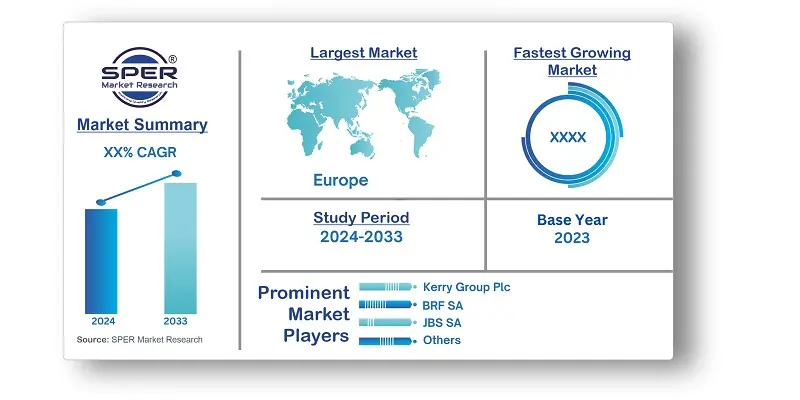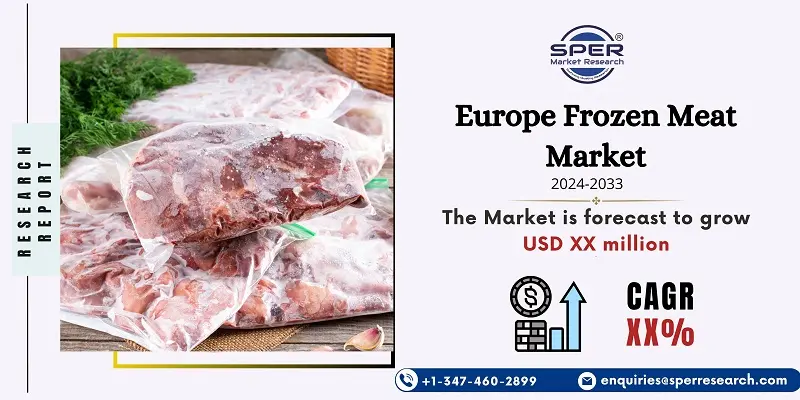
Europe Frozen Meat Market Growth, Size, Trends, Demand, Share, Revenue and Future Outlook
Europe Frozen Meat Market Size- By Product Type, By End User, By Distribution Channel- Regional Outlook, Competitive Strategies and Segment Forecast to 2033
| Published: Apr-2024 | Report ID: FOOD2444 | Pages: 1 - 152 | Formats*: |
| Category : Food & Beverages | |||
- In Mullica Hill, New Jersey, United States, Verde Farms opened its self-beef processing facility on November 6, 2019.
- Cargill has completed the acquisition of Proportion Foods, a US-based company that produces cooked meats, on January 27, 2021.


| Report Metric | Details |
| Market size available for years | 2020-2033 |
| Base year considered | 2023 |
| Forecast period | 2024-2033 |
| Segments covered | By Product Type, By End User, By Distribution Channel |
| Regions covered | UK, France, Germany, Italy, Spain, Rest of Europe |
| Companies Covered | Associated British Foods, Kerry Group Plc, BRF SA, JBS SA, Verde Farms LLC, Pilgrim's Pride Corporation, Marfrig Global Foods SA, Tyson Foods, Inc, Cargill Inc, VH Group, Others. |
- Retailers and Distributors
- Foodservice Providers
- Food Manufacturers
- Consumers
| By Product Type: |
|
| By End User: |
|
| By Distribution Channel: |
|
- Europe Frozen Meat Market Size (FY'2024-FY'2033)
- Overview of Europe Frozen Meat Market
- Segmentation of Europe Frozen Meat Market By Product Type (Pork, Beef, Chicken)
- Segmentation of Europe Frozen Meat Market By End User (Foodservice, Retail Customers)
- Segmentation of Europe Frozen Meat Market By Distribution Channel (Supermarket/Hypermarket, Convenience Stores, Online)
- Expansion Analysis of Europe Frozen Meat Market
- Problems and Obstacles in Europe Frozen Meat Market
- Competitive Landscape in the Europe Frozen Meat Market
- Impact of COVID-19 and Demonetization on Europe Frozen Meat Market
- Details on Current Investment in Europe Frozen Meat Market
- Competitive Analysis of Europe Frozen Meat Market
- Prominent Players in the Europe Frozen Meat Market
- SWOT Analysis of Europe Frozen Meat Market
- Europe Frozen Meat Market Future Outlook and Projections (FY'2024-FY'2033)
- Recommendations from Analyst
1.1. Scope of the report1.2. Market segment analysis
2.1. Research data source2.1.1. Secondary Data2.1.2. Primary Data2.1.3. SPER’s internal database2.1.4. Premium insight from KOL’s2.2. Market size estimation2.2.1. Top-down and Bottom-up approach2.3. Data triangulation
4.1. Driver, Restraint, Opportunity and Challenges analysis4.1.1. Drivers4.1.2. Restraints4.1.3. Opportunities4.1.4. Challenges4.2. COVID-19 Impacts of the Europe Frozen Meat Market
5.1. SWOT Analysis5.1.1. Strengths5.1.2. Weaknesses5.1.3. Opportunities5.1.4. Threats5.2. PESTEL Analysis5.2.1. Political Landscape5.2.2. Economic Landscape5.2.3. Social Landscape5.2.4. Technological Landscape5.2.5. Environmental Landscape5.2.6. Legal Landscape5.3. PORTER’s Five Forces5.3.1. Bargaining power of suppliers5.3.2. Bargaining power of buyers5.3.3. Threat of Substitute5.3.4. Threat of new entrant5.3.5. Competitive rivalry5.4. Heat Map Analysis
6.1. Europe Frozen Meat Market Manufacturing Base Distribution, Sales Area, Product Type6.2. Mergers & Acquisitions, Partnerships, Product Launch, and Collaboration in Europe Frozen Meat Market
7.1. Europe Frozen Meat Market Size, Share and Forecast, By Product Type, 2020-20267.2. Europe Frozen Meat Market Size, Share and Forecast, By Product Type, 2027-20337.3. Pork7.4. Beef7.5. Chicken
8.1. Europe Frozen Meat Market Size, Share and Forecast, By End User, 2020-20268.2. Europe Frozen Meat Market Size, Share and Forecast, By End User, 2027-20338.3. Foodservice8.4. Retail Customers
9.1. Europe Frozen Meat Market Size, Share and Forecast, By Distribution Channel, 2020-20269.2. Europe Frozen Meat Market Size, Share and Forecast, By Distribution Channel, 2027-20339.3. Supermarket/Hypermarket9.4. Convenience Stores9.5. Online
10.1. Europe Frozen Meat Market Size and Market Share
11.1. Europe Frozen Meat Market Size and Market Share By Region (2020-2026)11.2. Europe Frozen Meat Market Size and Market Share By Region (2027-2033)11.3. UK11.4. France11.5. Germany11.6. Italy11.7. Spain
11.8. Rest of Europe
12.1. Asssociated British Foods12.1.1. Company details12.1.2. Financial outlook12.1.3. Product summary12.1.4. Recent developments12.2. Kerry Group Plc12.2.1. Company details12.2.2. Financial outlook12.2.3. Product summary12.2.4. Recent developments12.3. BRF SA12.3.1. Company details12.3.2. Financial outlook12.3.3. Product summary12.3.4. Recent developments12.4. JBS SA12.4.1. Company details12.4.2. Financial outlook12.4.3. Product summary12.4.4. Recent developments12.5. Verde Farms LLC12.5.1. Company details12.5.2. Financial outlook12.5.3. Product summary12.5.4. Recent developments12.6. Pilgrim’s Pride Corporation12.6.1. Company details12.6.2. Financial outlook12.6.3. Product summary12.6.4. Recent developments12.7. Marfrig Global Foods SA12.7.1. Company details12.7.2. Financial outlook12.7.3. Product summary12.7.4. Recent developments12.8. Tyson Foods, Inc12.8.1. Company details12.8.2. Financial outlook12.8.3. Product summary12.8.4. Recent developments12.9. Cargill Inc12.9.1. Company details12.9.2. Financial outlook12.9.3. Product summary12.9.4. Recent developments12.10. VH Group12.10.1. Company details12.10.2. Financial outlook12.10.3. Product summary12.10.4. Recent developments12.11. Others
SPER Market Research’s methodology uses great emphasis on primary research to ensure that the market intelligence insights are up to date, reliable and accurate. Primary interviews are done with players involved in each phase of a supply chain to analyze the market forecasting. The secondary research method is used to help you fully understand how the future markets and the spending patterns look likes.
The report is based on in-depth qualitative and quantitative analysis of the Product Market. The quantitative analysis involves the application of various projection and sampling techniques. The qualitative analysis involves primary interviews, surveys, and vendor briefings. The data gathered as a result of these processes are validated through experts opinion. Our research methodology entails an ideal mixture of primary and secondary initiatives.



Frequently Asked Questions About This Report
PLACE AN ORDER
Year End Discount
Sample Report
Pre-Purchase Inquiry
NEED CUSTOMIZATION?
Request CustomizationCALL OR EMAIL US
100% Secure Payment






Related Reports
Our Global Clients
Our data-driven insights have influenced the strategy of 200+ reputed companies across the globe.




















